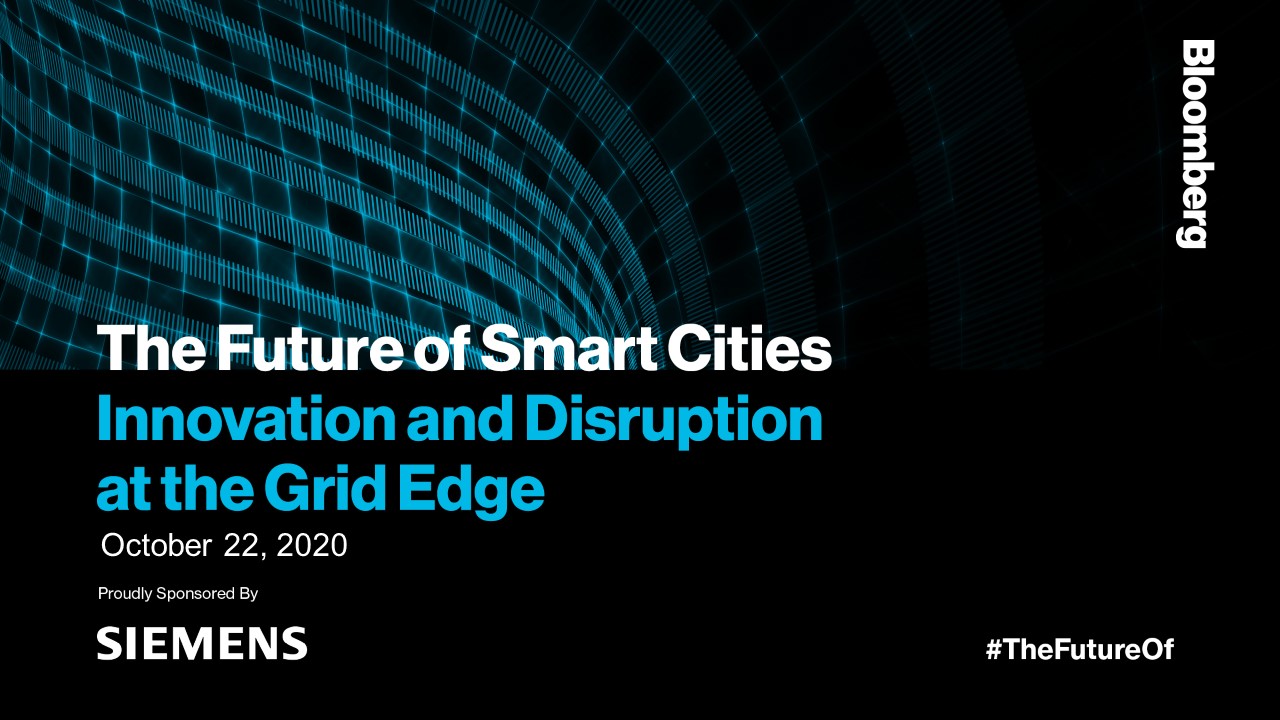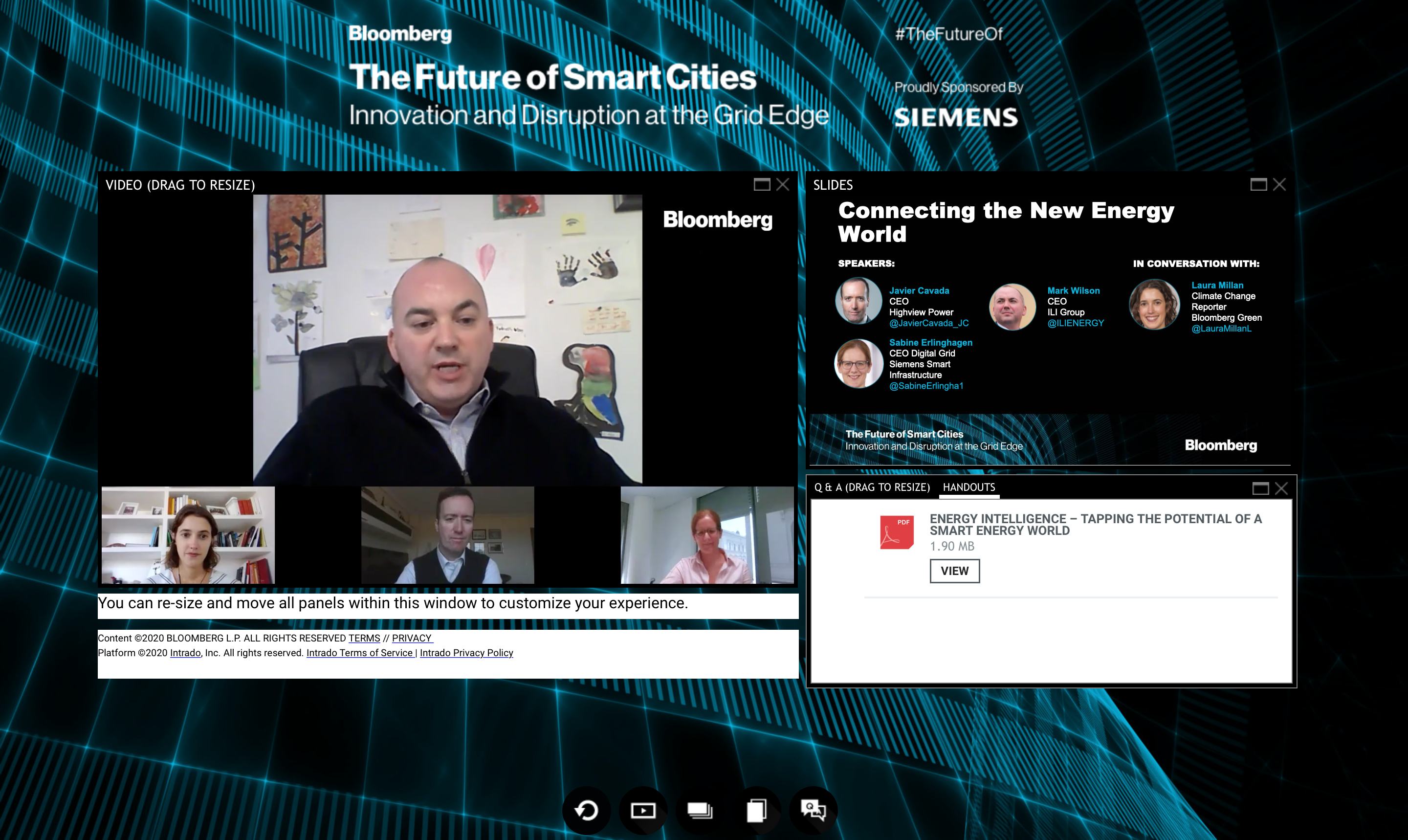By Sasha Qadri, Bloomberg Live
At Bloomberg’s October 22nd virtual event, The Future of Smart Cities: Innovation and Disruption at the Grid Edge, Laura Millan, Climate Change Reporter, Bloomberg Green, and Akshat Rathi, Reporter, Bloomberg Green, engaged in a series of conversations with key figures within the field of grid edge.
The event started with a panel discussion focused on different technologies that help make the grid smarter; participants included Javier Cavada, CEO, Highview Power, Sabine Erlinghagen, CEO, Digital Grid Siemens Smart Infrastructure, and Mark Wilson, CEO, ILI Group.
This was followed by a conversation on new entrants in the grid edge market as well as the impact of regulation. This panel comprised: Tom Chadwick, CEO, GI Energy, Greg Jackson, Founder and CEO, Octopus Energy, and Sandrine Mubenga, CEO, D.R. Congo Electricity Regulatory Authority and President, STEM DRC Initiative.
Keep reading for more key insights — and you can watch the full event here.

A few of the event highlights:
- Javier Cavada, CEO, Highview Power, articulated one of the main issues to be addressed. “The enormous challenge is how to balance, how to flatten the curve of generation and satisfy the demand. The security of supply is a fundamental question which we must answer.”
- On security, Cavada continued, “We need to ensure the resilience and availability of power at any time in any condition. That means the reliability of the generated power needs to be safeguarded. When we talk about security of supply, we talk about electronics, the cyber threats, the cyber security part of it. How to integrate all the different devices and technologies that are connected together. Smart electronics and energy storage — those are the two points that need to be safeguarded and protected.”
- Sabine Erlinghagen, CEO, Digital Grid Siemens Smart Infrastructure, sponsor of the briefing, described the opportunities that grid edge can bring to the table. “Grid edge is the opportunity to accelerate the energy transition to a pace fast enough to meet our carbon emission targets. This means installing renewables at a very fast pace, at the same time adding storage and making the whole thing intelligent enough to keep the grid stable at the same time. That’s a huge opportunity not only for the economy and for the energy transition and for net zero target, but also an interesting business to be in.”
- Erlinghagen stated, “The challenge of cyber security is ever-emerging. At the micro-grid level, we see everything connected from the battery to the storage. But micro-grids are rarely islands, they are connected to the grid … so that opens up intrusion possibilities into that very system. What you need these days is protection concepts. You can also outsource that with a managed service.”
- Erlinghagen emphasized the importance of acting now. “Covid has shown how vividly we can react to a crisis. If we compare that to the climate challenge, it should instill in society and in us that we can do something about that crisis and alter the course of action in a much more radical way than in the past. The grid edge is one way of doing that really fast. If we get a grid edge going, it will, by definition, help the energy transition. I’m very convinced that the grid edge is the chance in an accelerated way to achieve that net zero target. It will be much faster, much more socially accepted and likely much cheaper than building that large-scale infrastructure. The challenge then remains: How to incentivize that.”
- Mark Wilson, CEO, ILI Group, was optimistic about the potential for technology to enable achieving renewable energy targets. “One hundred percent renewable energy for all households by 2030 — we believe that is achievable, but you need energy storage alongside that. There are a number of technologies that can help. There is no silver bullet, but combined with different technologies working together, we firmly believe you can achieve these targets.”
- On addressing climate change, Wilson called on governments to initiate policy change. “A lot of people look at this and say it’s complicated. It really isn’t. What we do need is for the UK government to look at policy specifically for long-term storage. These projects for a pump storage, you’re talking several hundred million to construct over a period of time. For investors to commit to that type of investment, there need to be some long-term price signals. Investors need some certainty on a floor price so that they do invest.”

- Tom Chadwick, CEO, GI Energy, discussed a key factor within energy storage. “One thing that has been a big driver is the cost reduction in terms of the pieces of equipment and the software that ties these assets together. Our company has been the beneficiary of radical drops in price in terms of energy storage.”
- Chadwick advocated a regulated approach in the U.S. “I’m an advocate that micro-grids need to be more regulated and standardized so that they can be integrated into the existing grid as there is still a lot of pushback from the incumbents to this.”
- Greg Jackson, Founder and CEO, Octopus Energy, talked about the complete inversion of the energy supply chain. “For the renewable revolution, for the decarbonization of transport and heat, the consumer needs to be at the heart of it. If you’ve got renewable generations which are intermittent, you need to be able to change demand to match generation — the exact opposite of how it used to be. Incumbents are going to have to think about customers. If incumbents want to get ready for this new world, they need to be ready for a new level of customer engagement.”
- Jackson called out the need for energy to become more data-driven. “Energy very rapidly has to become a technology sector. Energy is now a big data market. If we look at the way that grids are often organized, it looks like a mini cab office. There are people sitting with switches, levers and telephones — and yet we’ve moved in transport from mini cabs to Uber where large amounts of data and algorithms are matching supply and demand continually in a very localized market and energy now needs to do the same.”
- On batteries, Jackson said, “With renewables, the requirements for storage and the opportunity to make money through storage are high. But we still have a world in which in every grid system we have artificial markets. What we really need is to expose the price of electrons at every stage in the grid and then investment can flow to the places that need storage. We really need to open it up with an enormous amount of date and price signals so investment can go to the places where it’s needed. We have to move away from a world of trying to centrally plan all of this.”

- Sandrine Mubenga, CEO, D.R. Congo Electricity Regulatory Authority and President, STEM DRC Initiative, highlighted the importance of investment in clean energy. “Ninety percent of the population doesn’t have access to electricity even though the Congo has the potential to produce 100,000 megawatts of clean hydro power. So, as the regulator, my role is to regulate the electricity market so we can attract more investors, have more operators and, ultimately, increase access to electricity that is clean and doesn’t negatively affect the earth.
- On batteries, Mubenga stated, “Thinking about how to use batteries in the Congo is always on my mind, especially because the Congo contains 60% of the world’s reserve of cobalt, which is used to make lithium ion batteries, and also produces lithium and all the minerals that you need to create clean technology. Currently, 99% of the electricity we generate is hydro, but we also have micro-grid in the Congo and this is actually one of the preferred ways for rural areas.”
- For Mubenga, standards are key. “Part of the regulator’s duty is to develop standards as we need to have standards in place so we can easily integrate all those technologies into the grid. We have a fantastic opportunity as we are building the grid from scratch so we want to build the grid in the smart way. We want to build a smart grid.”
Bloomberg’s The Future of Smart Cities: Innovation and Disruption at the Grid Edge was proudly sponsored by

——————————
Join the Conversation: #TheFutureOf
Instagram: @BloombergLive
LinkedIn: Bloomberg Live
Twitter: @BloombergLive
Interested in more Bloomberg Live virtual events? Sign up here to get alerts.
——————————